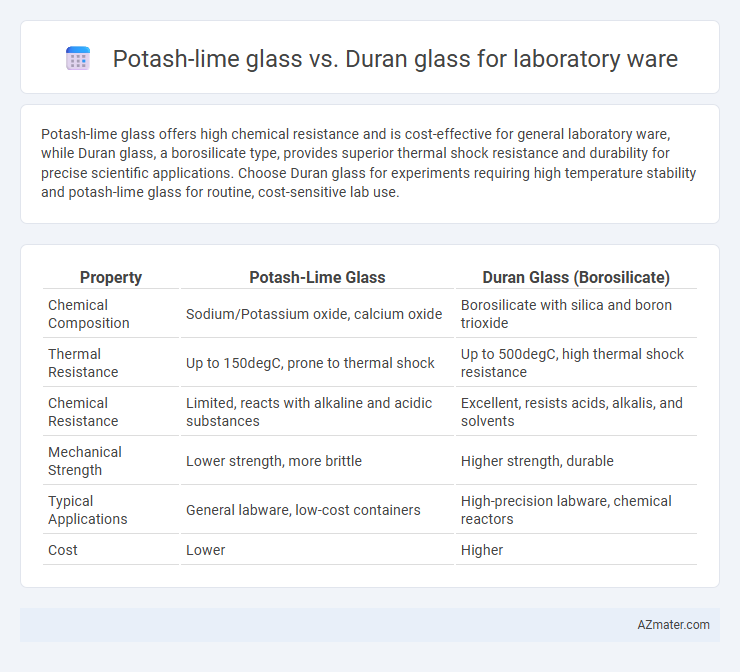Potash-lime glass offers high chemical resistance and is cost-effective for general laboratory ware, while Duran glass, a borosilicate type, provides superior thermal shock resistance and durability for precise scientific applications. Choose Duran glass for experiments requiring high temperature stability and potash-lime glass for routine, cost-sensitive lab use.
Table of Comparison
| Property | Potash-Lime Glass | Duran Glass (Borosilicate) |
|---|---|---|
| Chemical Composition | Sodium/Potassium oxide, calcium oxide | Borosilicate with silica and boron trioxide |
| Thermal Resistance | Up to 150degC, prone to thermal shock | Up to 500degC, high thermal shock resistance |
| Chemical Resistance | Limited, reacts with alkaline and acidic substances | Excellent, resists acids, alkalis, and solvents |
| Mechanical Strength | Lower strength, more brittle | Higher strength, durable |
| Typical Applications | General labware, low-cost containers | High-precision labware, chemical reactors |
| Cost | Lower | Higher |
Introduction to Laboratory Glassware Materials
Potash-lime glass and Duran glass are common materials used in laboratory glassware, each offering distinct chemical and physical properties. Potash-lime glass is more economical and suitable for general laboratory use but has lower thermal and chemical resistance compared to the borosilicate-based Duran glass. Duran glass provides superior durability, resistance to thermal shock, and chemical inertness, making it ideal for high-precision and demanding laboratory applications.
Overview of Potash-lime Glass
Potash-lime glass is a common type of laboratory glassware material known for its moderate chemical durability and lower cost compared to borosilicate glass varieties like Duran glass. It primarily consists of silica (SiO2), potash (K2O), and lime (CaO), offering good mechanical strength but limited resistance to thermal shock and strong chemicals. While suitable for general laboratory applications such as containers and simple apparatus, potash-lime glass is less appropriate for high-precision or high-temperature experiments where Duran glass's enhanced thermal and chemical resistance is preferred.
Overview of Duran Glass
Duran glass, a borosilicate glass, offers superior thermal resistance and chemical durability compared to potash-lime glass, making it ideal for rigorous laboratory applications. Its low thermal expansion coefficient reduces the risk of breakage during rapid temperature changes, enhancing safety and longevity in lab environments. Duran glass's excellent resistance to acids, alkalis, and solvents ensures reliable performance in diverse chemical processes.
Chemical Composition Comparison
Potash-lime glass consists primarily of silica (SiO2), potassium oxide (K2O), sodium oxide (Na2O), and lime (CaO), offering moderate chemical resistance but lower thermal stability. Duran glass, a type of borosilicate glass, incorporates silica (SiO2) and boron trioxide (B2O3) with additives like soda (Na2O) and alumina (Al2O3), providing enhanced chemical durability and resistance to thermal shock. The presence of boron trioxide in Duran glass distinctly improves its chemical resistance compared to potash-lime glass, making it preferable for laboratory applications involving aggressive chemicals.
Thermal Resistance and Durability
Potash-lime glass exhibits lower thermal resistance compared to Duran glass, often withstanding temperatures up to 150degC, making it suitable for general laboratory applications with minimal thermal stress. Duran glass, a borosilicate type, provides superior thermal resistance up to 500degC, ensuring minimal expansion and high durability under rapid temperature changes and thermal shock. The enhanced chemical stability and impact resistance of Duran glass contribute to its widespread use in high-precision laboratory ware requiring long-term durability and safety.
Chemical Resistance to Acids and Bases
Potash-lime glass exhibits moderate chemical resistance but is susceptible to attack by strong acids and bases, limiting its use in highly corrosive environments. Duran glass, a brand of borosilicate glass, offers superior chemical resistance to acids and alkalis due to its low-alkali borosilicate composition, making it ideal for laboratory ware exposed to aggressive chemicals. The enhanced durability of Duran glass against hydrofluoric acid and alkaline solutions ensures longer service life and maintains clarity under harsh chemical conditions.
Mechanical Strength and Breakage Rates
Potash-lime glass exhibits lower mechanical strength compared to Duran glass, making it more prone to breakage under mechanical stress and thermal shock in laboratory settings. Duran glass, a borosilicate glass, offers superior resistance to mechanical impacts and thermal fluctuations, resulting in significantly reduced breakage rates. Laboratories requiring durable ware often prefer Duran glass due to its enhanced toughness and longevity.
Typical Laboratory Applications
Potash-lime glass is commonly used for routine laboratory applications such as beakers, test tubes, and flasks due to its affordability and good chemical resistance to acids and alkalis. Duran glass, a type of borosilicate glass, excels in high-precision applications requiring thermal resistance and durability, including reflux condensers, volumetric flasks, and laboratory apparatus exposed to rapid temperature changes. Laboratories handling aggressive chemicals or requiring sterilization frequently prefer Duran glass for its resistance to thermal shock and superior mechanical strength.
Cost and Availability Differences
Potash-lime glass is generally more cost-effective and widely available compared to Duran glass, making it a popular choice for basic laboratory applications. Duran glass, a type of borosilicate glass, offers superior chemical resistance and thermal stability but comes at a higher price point due to its enhanced durability and manufacturing complexity. Laboratories requiring frequent exposure to high temperatures or aggressive chemicals often invest in Duran glass despite its elevated cost, while potash-lime glass suffices for routine, less demanding tasks.
Conclusion: Choosing the Right Glassware
Potash-lime glass offers cost-effective durability suitable for general laboratory applications, while Duran glass, a type of borosilicate glass, provides superior thermal resistance and chemical durability essential for high-precision experiments. Opting for Duran glass ensures enhanced resistance to thermal shock and chemical corrosion, making it ideal for rigorous laboratory processes involving extreme temperature changes or aggressive reagents. Selecting the right glassware depends on balancing budget constraints with the need for performance, where Duran glass outperforms potash-lime glass in maintaining integrity under demanding laboratory conditions.

Infographic: Potash-lime glass vs Duran glass for Laboratory ware
 azmater.com
azmater.com